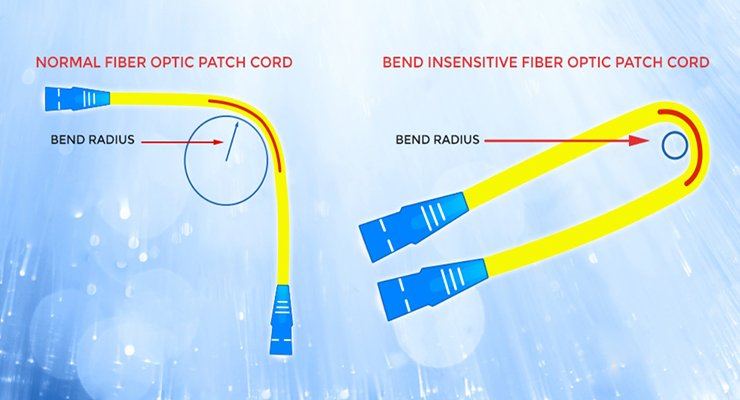Fiber is required to deliver low latency, which is crucial for a 5G fronthaul between the base station and the core network. Several fiber options can increase installation density and/or flexibility in this fronthaul.
Common choices include bend-insensitive fiber (BIF), OM5 fiber, ultra-low-loss (ULL) fiber, and reduced-diameter fiber. Each offers different performance tradeoffs for specific deployment needs, such as high density, long reach, and flexibility.
ITU-T G.657 and BIF
The International Telecommunications Union (ITU) standard ITU-T G.657 specifies the performance requirements for single-mode optical fibers resistant to bending (BIF). BIF is especially useful in challenging indoor environments, such as 5G micro base stations, where limited space and cabling is complex and dense.
BIF bend performance is quantified by measuring the optical loss introduced when the fiber is bent to a specified radius, compared to a standard fiber at the same bend radius (Figure 1).
Figure 1. BIF cables are designed to minimize optical losses even in small radius bends. (Image: Nexus Net)
G.657.A2 and G.657.B2 have a minimum bend radius of 7.5 mm, and G.657.B3 has a 5 mm minimum bend radius. G.657.A fiber complies with the previous ITU-T G.652.D standard but provides about ten times better macro bending performance. G.657.B does not relate to any previous standard and supports an order of magnitude better bend performance than class G.657.A.
TIA-492AAAE and OM5
The primary standard for OM5 fiber is the Telecommunications Industry Association (TIA) 492AAAE, which defines it as a Wideband Multimode Fiber (called WBMMF in ISO/IEC 11801). TIA defines OM5 performance requirements as an extended wavelength range from 850 to 953 nm that supports shortwave wavelength division multiplexing (SWDM).
OM5 fiber also supports bidirectional (BiDi) technology, which allows simultaneous two-way communication using a different wavelength in each direction. SWDM supports ultra-high-speed data transmission over shorter distances, while BiDi is commonly used when minimizing the number of fibers, such as point-to-point connections, is crucial.
OM5 is important for 5G service providers because it’s widely used in cloud data centers where content is stored. It’s also well-suited for high-bandwidth 5G core networks and supports multiple wavelengths for efficient data transmission. Using 4-level pulse amplitude modulation (PAM4) and wavelength division multiplexing (WDM), OM5 optical fibers can support 150-meter cables handling up to 400 Gb/s data speeds, making them suited for 5G intra-data center connectivity.
ITU-T G.654E and ULL
The “E” in ITU-T G.654E refers to enhanced performance. Originally developed for submarine cables, these cables are also used in terrestrial long-haul and high-speed applications in 5G networks. ULL cables have a better optical signal-to-noise ratio (OSNR) and lower attenuation than other G.654 cables. For example, the attenuation at 1550 nm is specified to be ≤ 0.23 dB/km for G.654E cables and ≤ 0.3 dB/km for G.654D cables.
The ability to transmit data over longer distances with fewer amplifiers can lower overall network installation and operational costs. ULL cables achieve enhanced performance by combining a larger effective area of optical fiber, using higher-purity materials, and optimized cladding designs.
Reduced diameters
Reducing cable diameters is a common way to increase interconnect density in 5G installations. Smaller cables can be especially useful when dealing with cable pipeline size limitations.
A fiber optic cable has several elements. The fiber optic core is contained in a glass cladding that’s typically 125 µm in diameter, and the cladding is surrounded by a protective coating that’s 250 µm thick. Reducing the coatings’ thickness can shrink the fiber optic cable’s diameter without affecting the fiber’s size or the cladding, enabling three cables to fit into a pipeline that previously carried two cables (Figure 2).

Figure 2. Reducing the coating thickness can significantly shrink the diameter of fiber optical cables. (Image: FS)
No industry standard exists for reduced-diameter cables, unlike fiber types like OM5 and ULL. The industry standard cable diameter is 250 µm, but reduced-diameter cables are available with thicknesses from 200 to 180 µm. Various fiber optic cable manufacturers offer OM5, ULL, and other types of fibers in reduced-diameter cables.
Summary
Fiber optic cables can support the high bandwidths and low latencies required for 5G fronthaul installations. Several international standards define BIF, OM5, and ULL cables. In addition, the industry has independently developed materials and manufacturing techniques to produce cables with reduced diameters and support higher installation densities.
References
5 Types of Fiber Optic Cables for 5G Networks, FS
An Economic Comparison of Fronthaul Architectures for 5G Networks, Cisco
Fiber in 5G Networks, ElectroRent
Fronthaul, Viavi
How Time-Sensitive Networking Benefits Fronthaul Transport, IEEE Standards Association
ITU-T G.654.E Fiber, Sumitomo Electric
Reliable and cost-efficient protection scheme for 5G fronthaul/backhaul network, Heliyon
What is 25G WDM Technology of 5G Fronthaul, Fiber Mall
EEWorld Online related content
Five reasons why TSN over 5G promises timely deliveries
5G fronthaul networks add flexibility
High-speed data challenges physical-layer optics
How are optical interconnects being miniaturized?
What embedded protocols can you use for optical connectivity?

